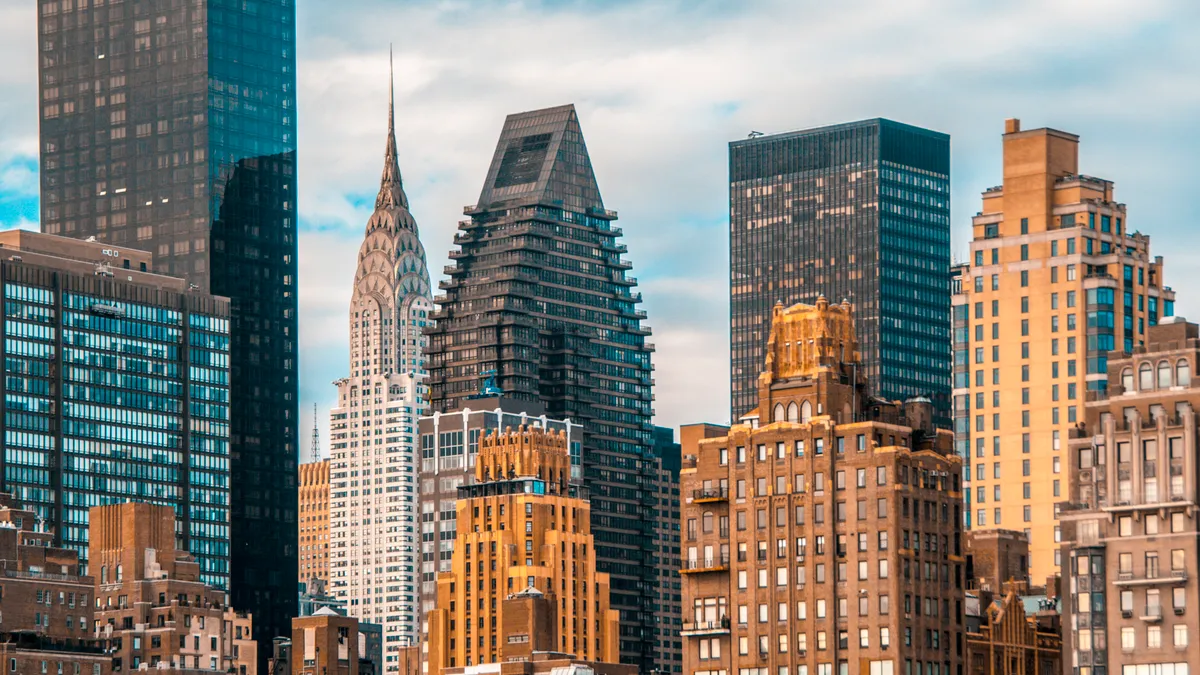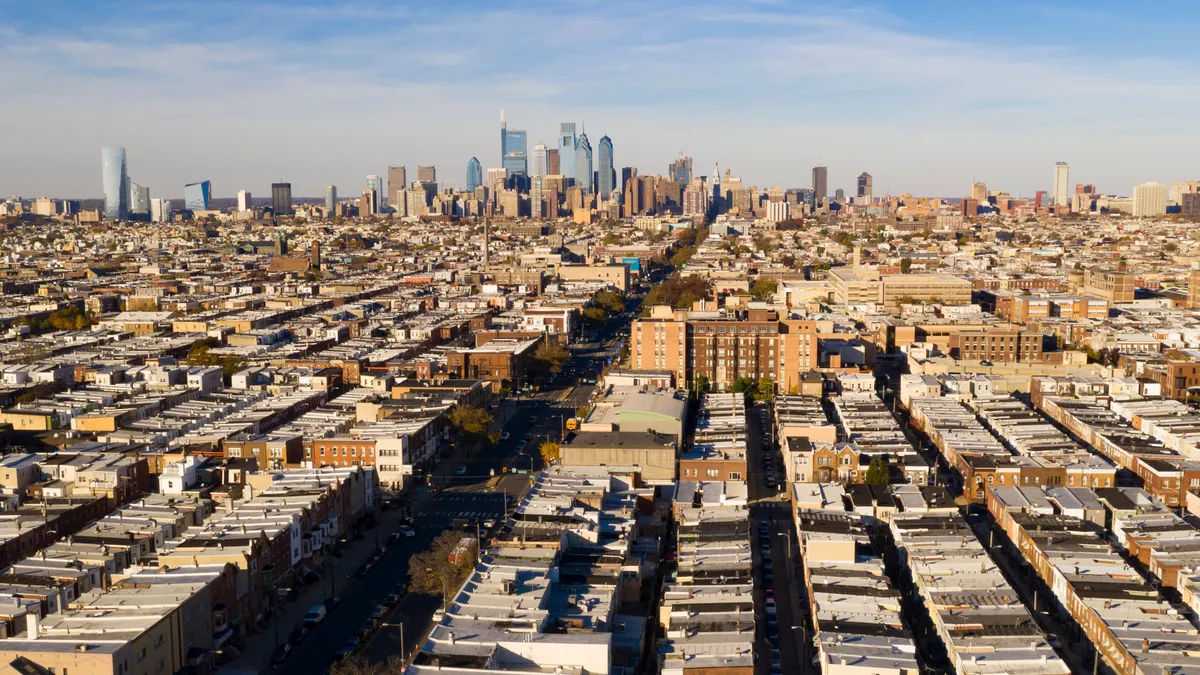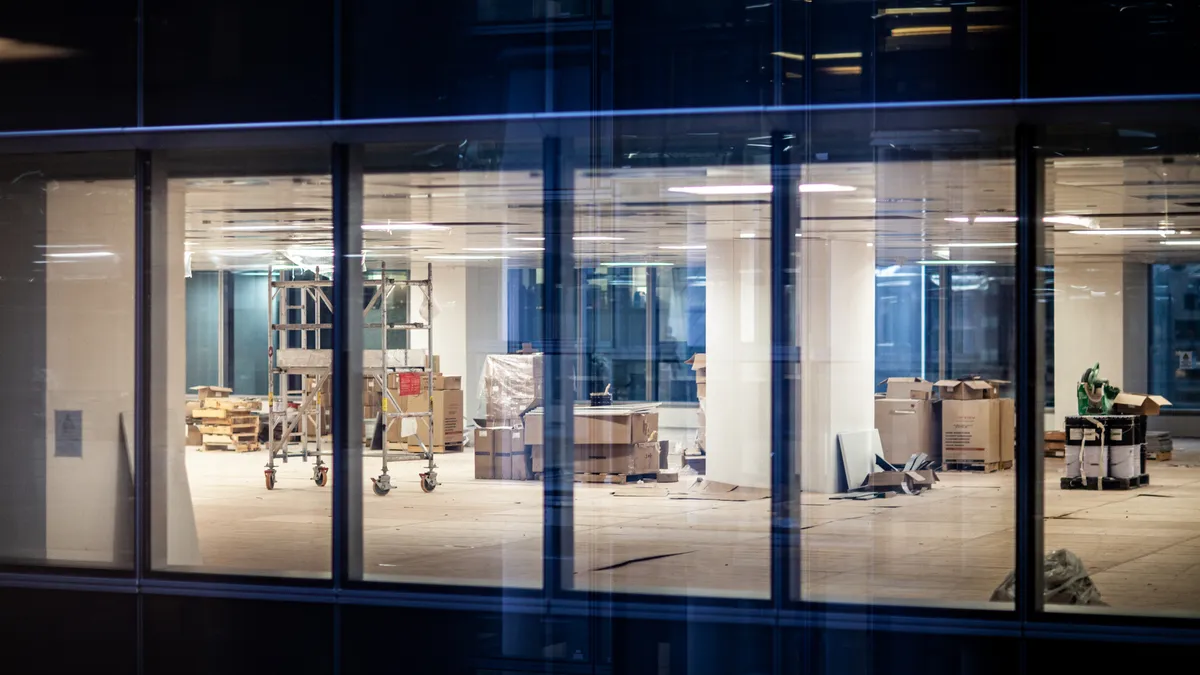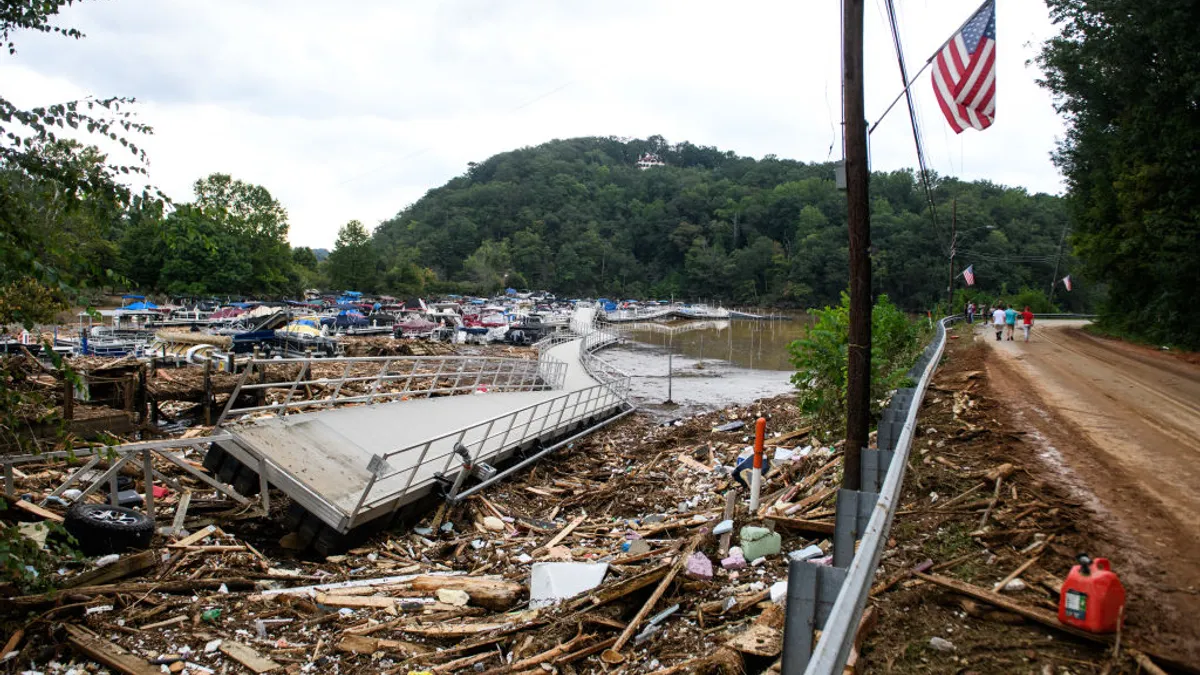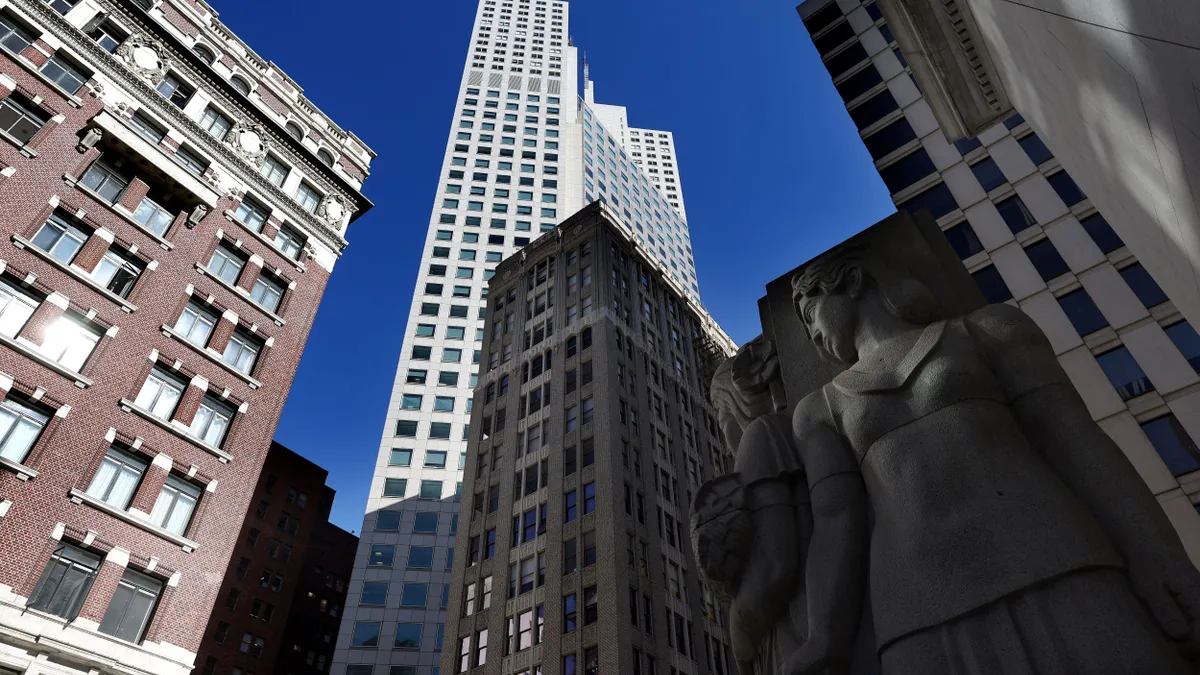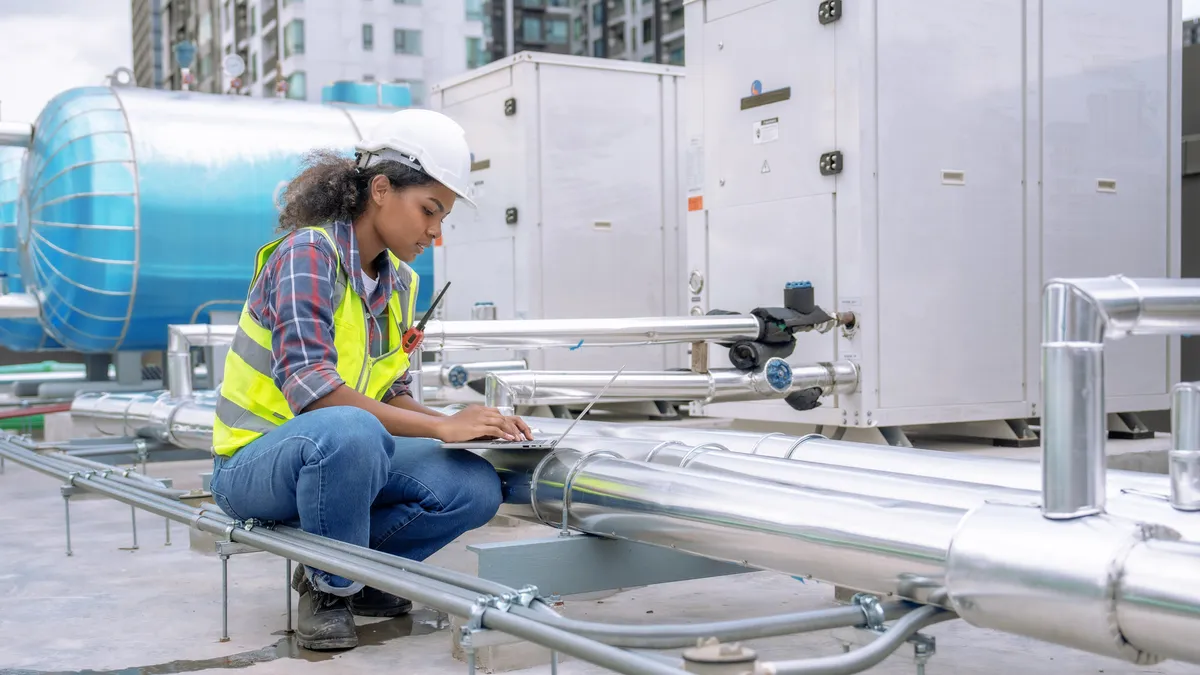New York City’s Local Law 97 entered its first compliance period Monday, mandating that close to 50,000 of the city’s largest buildings meet new energy efficiency requirements and greenhouse gas emissions limits that start in 2024.
The law requires buildings over 25,000 square feet to slash 40% of their emissions by 2030 and achieve an 80% reduction by 2040. Buildings that cannot meet the 2024 emissions caps can reduce noncompliance penalties for up to two years if they demonstrate a “good-faith” commitment to abide by the law.
Starting in 2024, the law assigns emissions limits for 60 different property types based on the building’s square footage and the emission factor associated with the property type. For example, during the 2024-2029 compliance period, data centers have a building code emissions intensity limit of 0.00846 metric tons of CO2 equivalent per square foot, while hotels and K-12 schools have limits of 0.00987 tCO2 per square foot and 0.00758 tCO2 per square foot, respectively.
Under the law, building owners could eventually be charged a penalty of $268 for every ton of carbon dioxide equivalent they emit above their annual allowance, the DOB said. As the legislation’s first penalty period takes effect, however, New York City’s buildings are surpassing initial compliance projections, easing concerns within the real estate industry about the challenges of meeting the law’s requirements. City data indicates that although roughly half of the city’s buildings were not compliant in 2019, 89% are now on track to meet the law’s 2024 emissions-reduction targets. The city notes that 63% of larger buildings are currently exceeding 2030 targets, however.
“The sentiment we hear from our customers is that a majority of the buildings that have already deployed technologies … will be compliant for the first compliance period, 2024-2029,” said Owen Glubiak, vice president of revenue at Cortex Sustainability Intelligence. Its customers, which include Class A commercial real estate owners in New York, are drawing on technology to align corporate energy reduction initiatives with building performance, he noted.
The Department of Buildings finalized LL97’s second major rules package on Dec. 18, establishing a new credit for building electrification and clarifying what constitutes a “good-faith effort” to comply. Critics have decried the reprieve on penalties, citing the additional environmental harm that would result from allowing higher emissions for two more years. “I'm splitting the difference between activism and pragmatism,” said Saleh ElHattab, founder and CEO of Gravity Climate, which provides energy efficiency and electrification solutions for building managers, warehouses and manufacturers in New York. “We should push these laws to be more stringent, but we should be pragmatic about the ability of buildings to succeed. Arm-twisting is not the recipe for success. Incentivizing [building owners and operators] with carrots, alongside those more stringent rules, I think is the winning recipe,” ElHattab said.
The law also sets energy conservation requirements for covered buildings that must be in place by Dec. 31. These include maintaining heating systems, repairing heating system leaks, adjusting temperature set points for heat and hot water to reflect appropriate space occupancy and facility requirements, insulating pipes and installing individual temperature controls or insulated radiator enclosures with temperature controls on all radiators.
Energy conservation is the cornerstone of a broader decarbonization strategy, said Frank Cuomo, general manager at Consolidated Edison. “You have to squeeze your building and facility as much as you can” to reduce its energy use. “And when you can’t any more, those are the investments you make in the heart and lungs of the building,” he said. Squeezing your loads as much as possible, or getting as much efficiency out of existing systems as possible, should be the first step, he said.
Glubiak noted that some energy conservation measures can come at little to no cost, such as optimal start-up or shut-down sequencing, continuous commissioning, demand management and fault detection. “These changes drive, on average, a 10% to 20% savings in energy use, carbon and cost,” he said.
Factors that make it challenging for buildings to comply with emissions standards include expected year-over-year increases in electricity consumption and their dependency on natural gas and other fossil fuels for heating and other purposes. Changing climate patterns, such as hotter summers and colder winters, are also driving higher energy consumption for both heating and cooling, ElHattab said.
“We map out reduction pathways for our customers rooted in energy efficiency and electrification. We often look at condenser loops — a heating and cooling system that uses water to regulate chiller loops — that they have on their roofs, and [systems] that intelligently set their temperatures and adjust them up or down,” he said, explaining strategies his firm uses to mitigate these challenges. “These are just simple retrofits,” he added. “It doesn’t require massive upgrades to your building. Retrofitting these systems will improve the energy efficiency of your heating and cooling by anywhere between 10% and 40%.”
Buildings that are already in compliance with the law are “generally in relatively advantaged communities,” New York City said in a report on the state of LL97, pointing to a need for additional support for buildings in less advantaged communities. Financial analysis by the city suggests that roughly 15,000 buildings will require an investment of $12 billion to $15 billion to meet the law’s 2030 emissions limits at current costs with existing technology. Energy savings will offset only $5 billion to $6 billion of those costs, the city said, noting that roughly 25% of buildings would be able to fully cover the costs of compliance through future energy savings.
Other buildings will need to undertake costlier “heart-transplant”-like measures, Cuomo said. “If you're changing out your building systems, you're changing out the heart of your building. Whether you're replacing gas boilers, etc.. Engineering planning, equipment procurement issues … all these things take time. If building owners and facilities managers haven't started looking at their options by now, they can't meet 2030 goals.”



